Travel system based on SpringBoot
- Development language: Java
- Database: MySQL
- Technology: SpringBoot+MyBatis+Vue.js
- Tools:IDEA/Ecilpse、Navicat、Maven
Roles are divided into administrators and ordinary users
- Administrators can manage personal information, user information, scenic spot information, scenic spot categories, hotel information, room information, forum information, message information, notification announcements, news information, etc., and can also review user reservations for tickets, hotels, etc.
- Users can register and log in, inquire about hotel rooms, attractions information, browse news, announcements, publish posts, book hotels, attractions, etc.
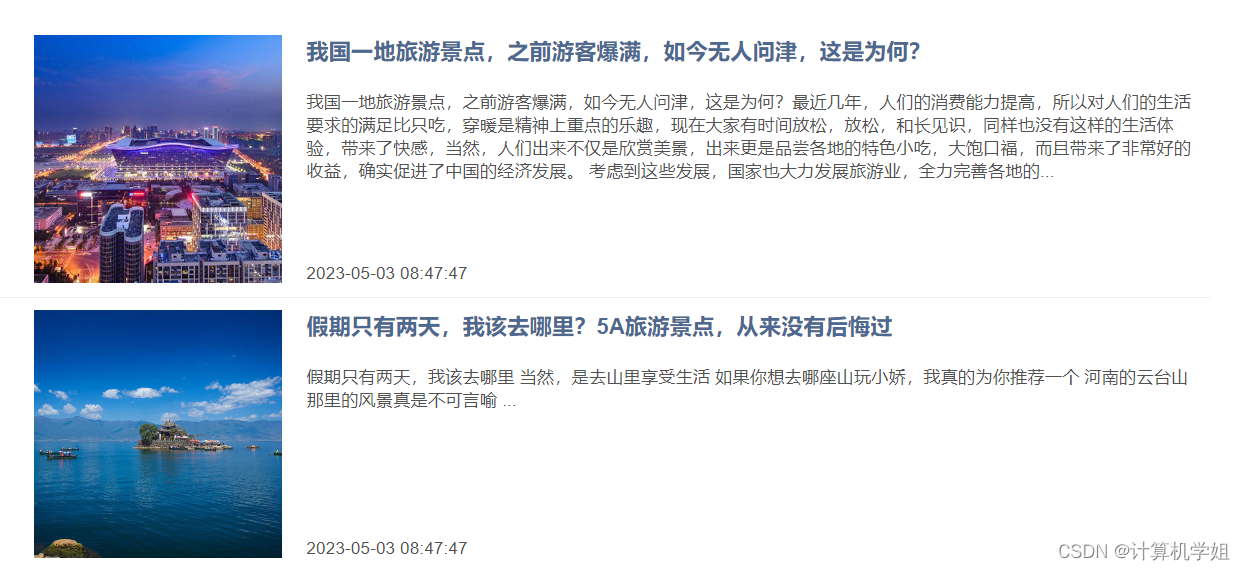

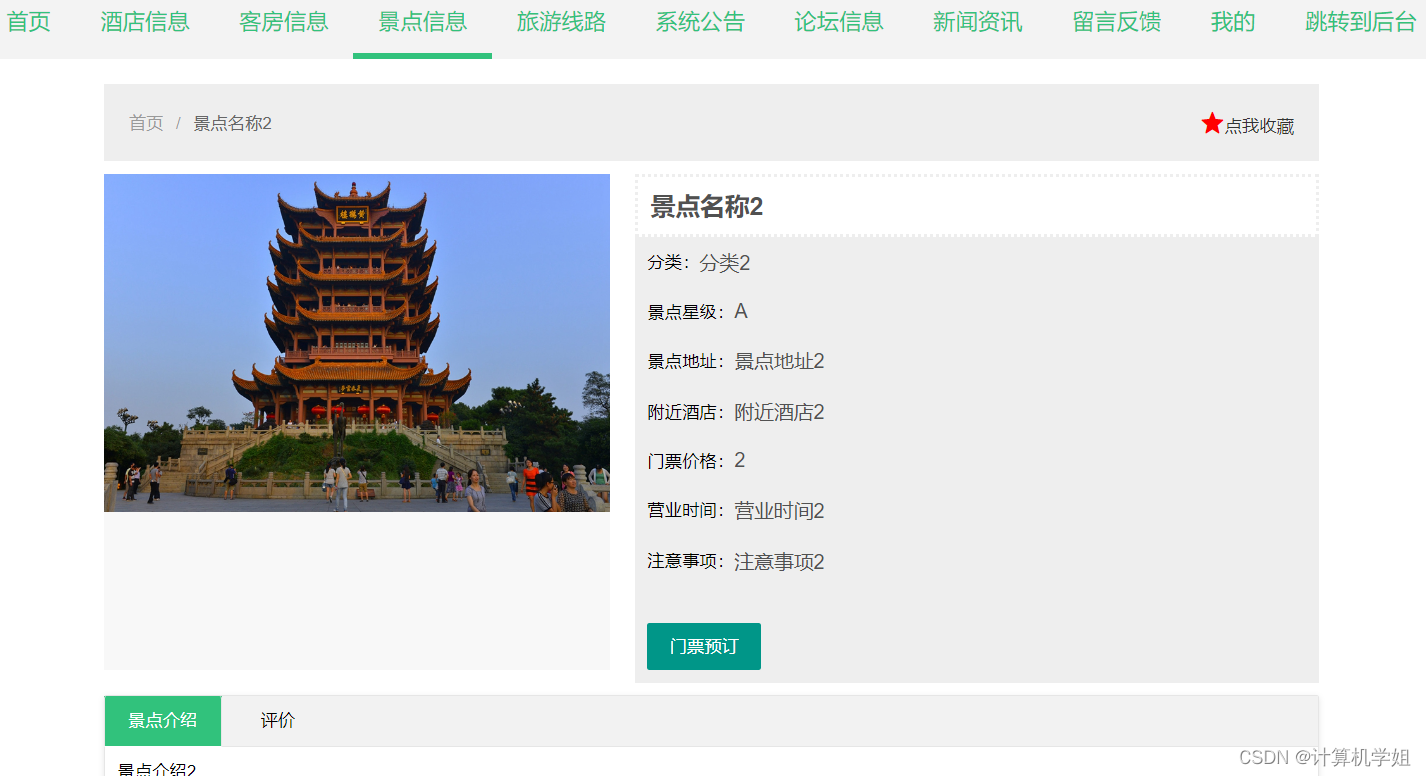
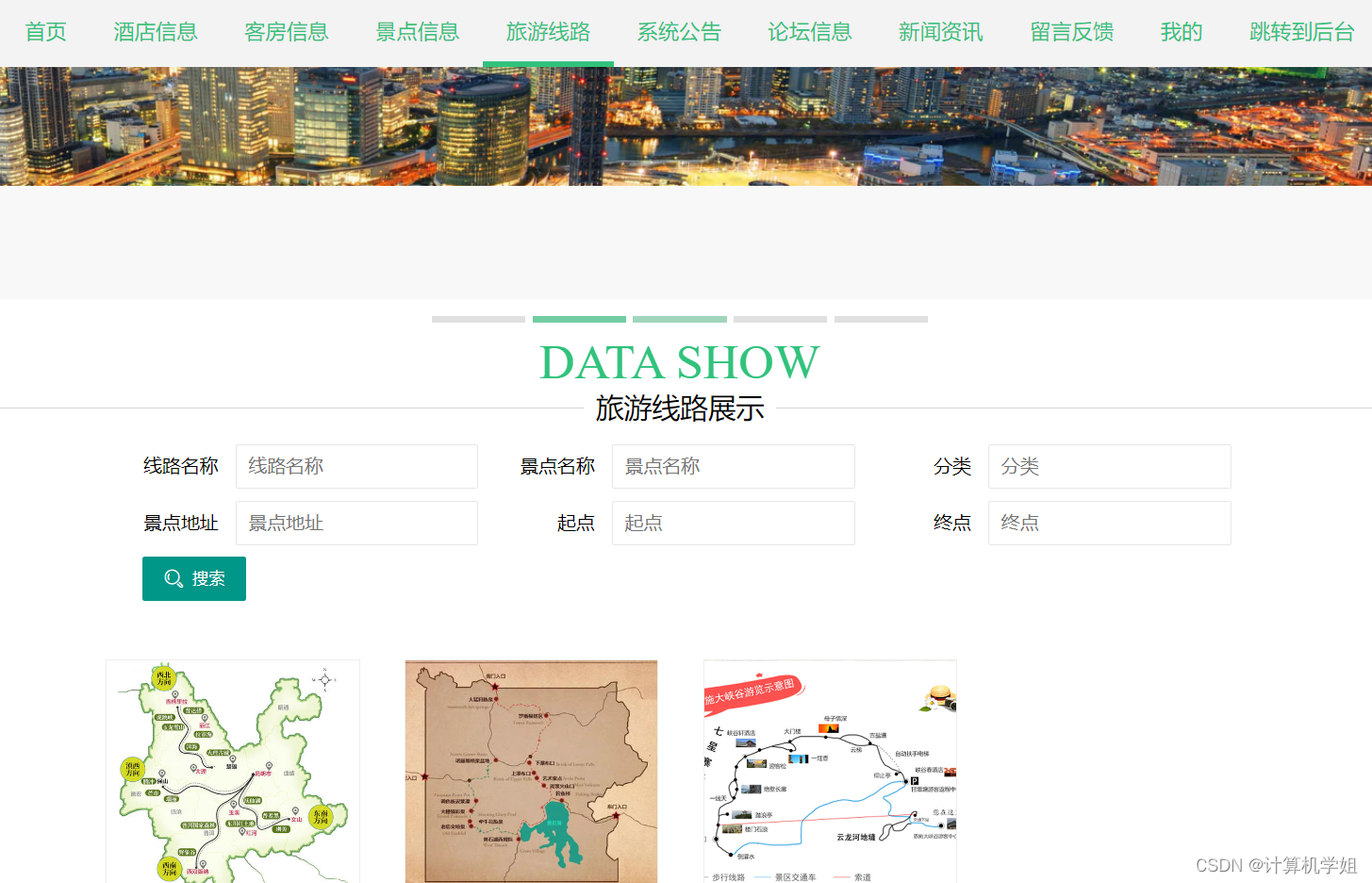
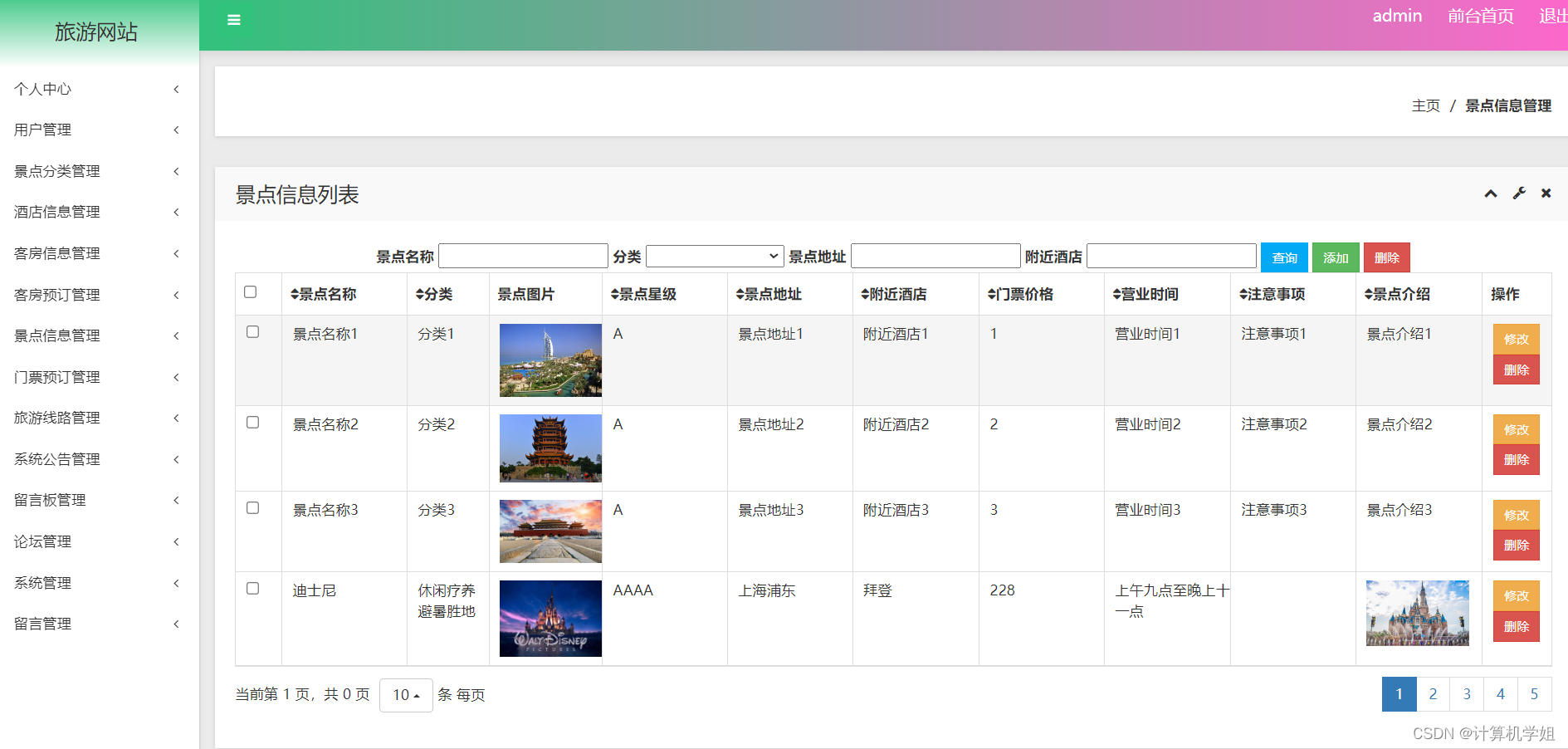
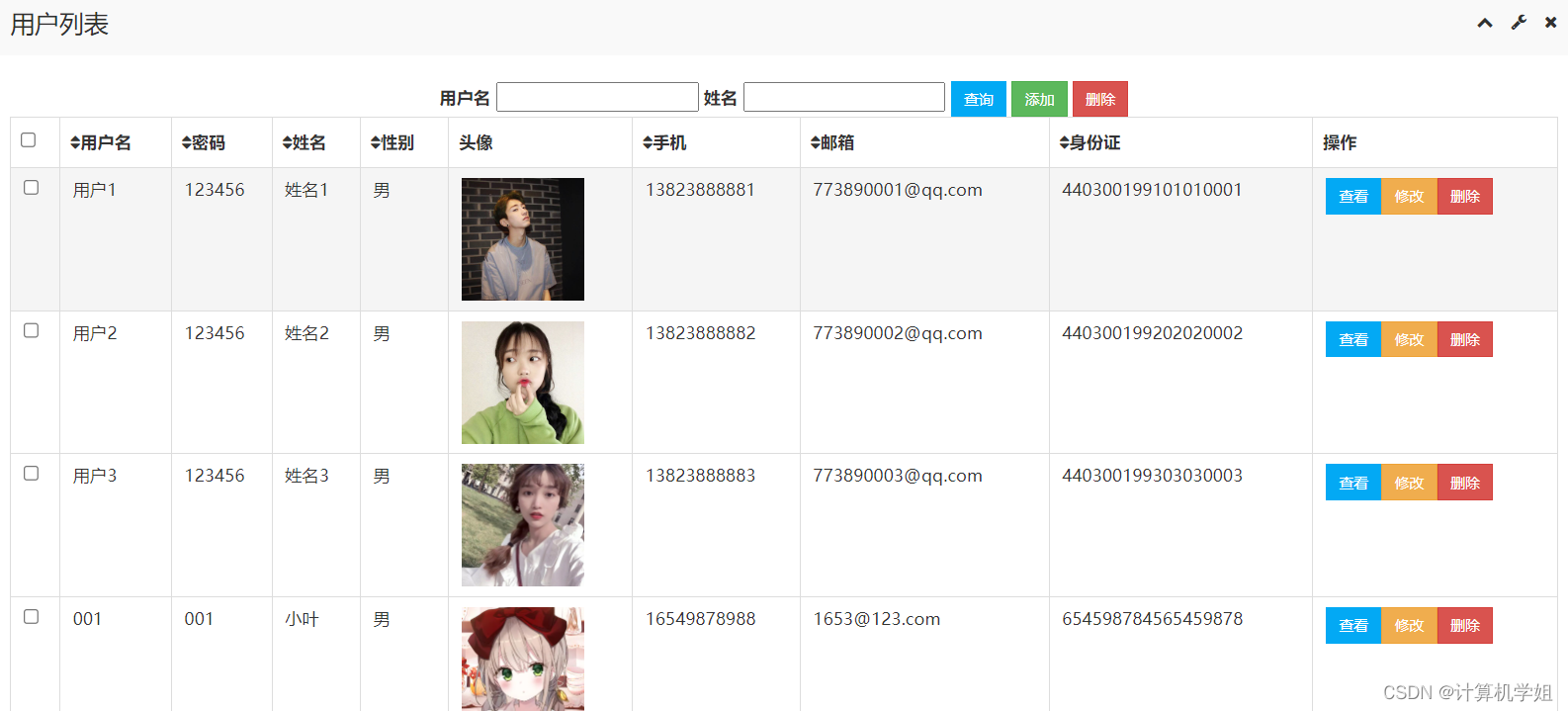
1 Introduction
1.1 Research background and purpose
In the initial development stage of tourism websites, many websites in our country have some common problems. One of them is the lack of a comprehensive understanding of the travel industry and network operations, which makes them unable to accurately find their entry point, which leads to a series of problems. First of all, the design is similar, the content is the same, lack of innovation and differentiation, and cannot attract users' interest and retention. Therefore, when developing a travel website, we need to have a deep understanding of the travel industry and network operations in order to fully understand market demand and user preferences. In addition, we should also pay attention to the establishment of a large-scale business model, and increase the success rate through effective online promotion and booking mechanisms to achieve more considerable tourism e-commerce sales.
Tourism websites are facing a bottleneck in the security of tourism product transactions. However, the online payment methods of most domestic tourism websites are imperfect, lacking a unified standard system, and the transaction security is worrying. Malicious ordering and transaction errors occur frequently, resulting in low consumer trust in online transactions. The key to solving this problem is to establish a sound payment system, strengthen identity verification and data encryption, and establish a complete customer service and complaint handling mechanism to improve transaction security and user trust. Therefore, the problem of transaction insecurity has become one of the biggest obstacles in the development of tourism websites.
In order to improve this situation, tourism websites should take the following measures: First, strengthen their own popularity and reputation, and increase exposure through active network marketing activities. Secondly, establish a reliable reputation system to ensure the reputation, security and credibility of the website, thereby increasing users' trust in the website. At the same time, formulate scientific management and operation standards, standardize the operation of the website, and guide users to conduct safe and reliable transactions on the website. In addition, the guidance and regulation of website content should be strengthened to ensure the authenticity and legality of the content. Finally, actively promote the construction of the operating system, improve the quality and safety of the website, and expand the influence of the website through advertising. Through these measures, tourism websites can improve the overall quality and security, enhance users' trust in the website, and promote business development.
1.2 Current status of this research and existing research basis
The research and development of tourism system has made some progress and foundation at present. At present, many tourism websites have been established and are operating in the market. However, many travel websites face a series of problems in the initial stage. First of all, they lack a comprehensive understanding of the travel industry and network operations, making it impossible to find the right entry point. Secondly, they often blindly imitate the ready-made models of other websites, lacking unique features and selling points. This situation has led to similar website design, similar content, and frequent repeated construction. In this way, a large-scale business model has not been formed, and online promotion and booking with a high success rate cannot be realized, resulting in meager sales of tourism e-commerce.
In the field of tourism system research, academia and industry have done some research and practice. In terms of academic research, some researchers have discussed and analyzed the needs of travel websites, user experience, information acquisition and transaction security. They propose some design principles and methods to improve the quality and user satisfaction of tourism websites. In addition, some studies have also focused on the integration of tourism systems with other fields, such as the application of technologies such as artificial intelligence, big data, and intelligent recommendation.
To sum up, the research and development of tourism system has made some progress, but there are still some challenges and problems. Future research can further explore the personalized customization, intelligent recommendation and user experience of the travel system to improve the system's effectiveness and user satisfaction. In addition, the integration of the tourism system with other fields can also be strengthened to open up a broader application field.
2. System requirements
2.1 Purpose of writing
The purpose of compiling the tourism system is to solve a series of problems faced by the current tourism industry and provide a comprehensive, convenient, safe and personalized tourism information and service platform. First of all, the tourism system is designed to meet the needs of users for tourism information. By integrating and displaying various tourist attractions, hotels, transportation and other relevant information, users can easily obtain detailed introductions of destinations, attractions features, transportation routes, hotel reservations and other information to help them make wise travel decisions. Second, the travel system is designed to provide convenient booking and ticketing services. Users can directly book scenic spot tickets, hotel accommodation, flight or train tickets online through the system, which saves cumbersome offline operations and waiting in line, and improves the efficiency and convenience of booking. In addition, the tourism system also pays attention to the individual needs and experience of users. Through the user's personal center and management functions, users can customize travel preferences, bookmark favorite attractions, write travel notes and share experiences, realizing personalized travel experience and social interaction. Writing a travel system also pays attention to transaction security and reputation building. The system should provide secure online payment channels and protection mechanisms to ensure the security of users' transaction information and funds. At the same time, establish a reputation system, evaluate and give feedback on attractions, hotels and service providers, provide reliable references, and enhance users' trust in the system. In general, the purpose of compiling the travel system is to build a comprehensive, convenient, safe and personalized travel information platform, provide users with high-quality travel services, promote the development of the travel industry and enhance the travel experience of users.
2.2 Development Background
2.2.1 Current trends
The tourism system is currently showing the following trends:
Mobility: More and more users use mobile devices to search, book and share travel information. Therefore, the travel system needs to provide responsive design and mobile application for convenient mobile experience.
Data-driven decision-making: With the help of big data and analysis technology, the tourism system collects and analyzes data such as user behavior, market trends, and competitive intelligence to support decision-making. Such data-driven decision-making can help tourism companies optimize operating strategies, improve products and services, and increase competitiveness.
Intelligent technology: Intelligent technologies such as artificial intelligence and machine learning are widely used in tourism systems. For example, voice assistants and chatbots can provide real-time customer support and consultation services; image recognition technology can be used to identify attractions and enhance travel experience; intelligent recommendation algorithms can provide users with personalized travel advice.
Socialization and sharing: The travel system is increasingly focused on socialization and sharing. Users can share travel experience, travel notes and photos in the system, and interact and communicate with other users. A social travel system can help users get more inspiration and suggestions, and increase user stickiness and participation.
Sustainability: Sustainability of the tourism system has become the focus of attention. The system encourages users to choose sustainable tourism products and services, such as environmentally friendly hotels, low-carbon transportation, etc. At the same time, the system can also provide relevant sustainable tourism information and education to promote the green development of tourism.
In conclusion, current trends in travel systems include mobility, personalized recommendations, data-driven decision-making, intelligent technology, socialization and sharing, and sustainable development. These trends will lead the development direction of the tourism system and provide better tourism experience and services.
2.2.2 Significance of using computer to manage tourism information
The development and application of tourism system cannot do without the help of computer. By using computer technology, the tourism system can better manage and process a large amount of tourism information, and provide efficient and accurate services. The use of tourism systems can greatly simplify the traditional way of tourism management. Through systematic data storage and processing, the waste of human and material resources can be reduced. For example, the system can centrally manage and update the information of tourist attractions, including attraction introductions, traffic routes, ticket prices, etc. Users can quickly query and obtain the required information through the system without manually searching various sources. Computer management can also improve query efficiency. The tourism system can quickly filter out tourist attractions, hotels and transportation plans that meet the requirements according to the needs and conditions of users through the search and filter functions. Users can make personalized selections and comparisons according to their own preferences and needs, improving the efficiency and accuracy of travel planning.
2.3 Reasons for launching a tourism information platform
The tourism system is developed to solve the cumbersome problems of management and information processing in the tourism industry. The system aims to provide a better way to manage a large amount of tourism-related information, reduce the workload of administrators, and effectively process and release these data so that users can obtain accurate and timely tourism information.
2.4 Specifications for performance
The system should ensure stability, have good operability and easy-to-master operation methods. At the same time, the security of the system should be strengthened to protect the security of user data and information.
2.5 Accuracy
This system strives to ensure the accuracy of the results. Whether in the process of data input, output or transmission, the system can meet various precision requirements to meet the needs of users. Depending on the use case and needs, the system provides the appropriate level of precision to ensure the accuracy and reliability of the results.
2.8 Feasibility analysis
The feasibility analysis of tourism system is to comprehensively evaluate the feasibility of a tourism project, including market demand, competitive environment, technical feasibility, economic feasibility, risk assessment and legal policy feasibility. The ultimate goal is to determine whether the project is worth investing in and implementing.
2.8.1 Operational Feasibility
The travel system has an intuitive and simple operation interface, and users can easily get started without complicated training. The operation guidance is simple and clear, enabling users to quickly get started and operate. In addition, the system has low operating environment requirements and is suitable for various infrastructure conditions. It can run stably no matter in the network environment or on hardware devices, providing users with convenience and flexibility, and users do not need to worry about hardware or software limitations.
2.8.2 Technical Feasibility
The system uses MySQL as the database management system, and adopts the master-slave database server architecture. This architecture improves system performance and reduces its limitations by providing a consistent interface to manage data. The master-slave database server allows the system to simultaneously perform read and write operations on multiple nodes to achieve efficient data management and processing, and to ensure data consistency and reliability. This architecture can effectively meet the needs of the system, and provide good scalability and performance optimization capabilities. This architecture enables the system to process a large amount of data more efficiently, and can meet the stability and reliability requirements of the system.
2.8.3 User Feasibility
The user feasibility analysis of the tourism system focuses on the system's user-friendliness, function compliance with requirements, response speed and performance, multi-platform compatibility, and user feedback and improvement. By ensuring that the system is easy to use, fully functional, efficient and stable, and compatible with a variety of devices, and actively listen to user feedback and make improvements, we can provide users with a satisfactory travel experience.
1. Software testing
6.1 Introduction
6.1.1 Purpose of writing
The purpose of this test plan is to verify whether the system meets the design requirements and can meet the functional requirements proposed by the instructor. The test will evaluate whether the various functions of the platform can run normally, and whether they meet the basic management requirements, such as query, delete and other operations. At the same time, the test will also ensure that the system can operate normally under various user conditions to verify its stability and reliability.
6.2 Task overview
6.2.1 Objectives
Testing is the process of executing a program with the aim of finding bugs in software. Its main purpose is to find and correct errors as much as possible before the software is put into production operation, so as to ensure the quality and stability of the software. Through testing, it can be verified whether the software meets the expected functional requirements, performance requirements and reliability requirements. Testing also helps to improve the usability and user experience of the software, ensuring that the software functions properly in real-world environments and meets user expectations.
6.2.2 Overview of Requirements
The system meets the functional requirements of user login, scenic spot management, hotel management, forum management, etc., and is easy to operate, so that users can easily get started regardless of their computer knowledge level. The system design takes maintainability into consideration, allowing regular maintenance and adjustments to database data and functions to ensure system performance and space utilization. In addition, the system also meets the requirements of openness, can run in an open hardware environment, and seamlessly connect with other systems.
6.3 Planning
6.3.1 Test items
6.3.2 Test preparation
Before the test, it is necessary to prepare the test method document of the corresponding module, including the test flow chart. At the same time, according to the overall outline of the general design specification and detailed design specification, select the appropriate input and output data, and make a detailed list and description. These preparations are to ensure the accuracy and completeness of the test.
6.4 Description of test items
6.4.1 Login interface for testing
Name: Login Test Purpose: Test if authentication is correct
Content: password input, legitimacy check, rationality check, interface display control.
Table 6-1 describes the records currently existing in the user table.
Table 6-1 Prestored data in the user table
| username | password | Role |
|---|---|---|
| admin | admin | administrator |
| 001 | 001 | user |
Table 6-2 describes the use cases for testing the user login interface, mainly to prevent existing defects and vulnerabilities in the login module.
Table 6-2 Login user test cases
| enter | expected output | actual output | ||
|---|---|---|---|---|
| username | password | role type | ||
| null | null | administrator | Account and password cannot be empty | Account and password cannot be empty |
| null | null | user | Account and password cannot be empty | Account and password cannot be empty |
| admin | 123 | administrator | Password error, please re-enter! | Password error, please re-enter! |
| 001 | 123456 | user | Password error, please re-enter! | Password error, please re-enter! |
| admin | admin | administrator | Log in to the main administrator interface | Log in to the main administrator interface |
| 001 | 001 | user | Log in to the tube user main interface | Log in to the main user interface |
6.4.2 User management for testing
Table 6-3 User management test cases
| enter | expected output | actual output | |
|---|---|---|---|
| functional module | operate | ||
| view personal information | Click on the Personal Information button | Jump to personal information page | Successfully jump to the personal information page |
| change Password | Click the Change Password button to change the password | Successfully modified | Successfully modified |
6.4.3 Attraction management for testing
Table 6-4 Attraction management test cases
| enter | expected output | actual output | |
|---|---|---|---|
| functional module | operate | ||
| View attraction information | Click the Attraction Information button | Jump to attraction information page | Successfully jump to the attraction information page |
| Add attraction information | Click the Add button to enter detailed attraction information | Added successfully | Added successfully |
| Modify attraction information | Find the scenic spot information that needs to be modified, and modify it to the correct information | Successfully modified | Successfully modified |
| Delete attraction information | Click to delete existing attraction information | successfully deleted | successfully deleted |
6.4.4 Hotel management for testing
Table 6-5 Hotel Management Test Cases
| enter | expected output | actual output | |
|---|---|---|---|
| functional module | operate | ||
| add hotel | Click the Add Hotel Information button | Prompt to add successfully | Added successfully |
| Modify hotel information | Find the hotel information that needs to be modified and modify it to the correct information | Successfully modified | Successfully modified |
| Delete View Hotel Information | Click to delete existing hotel information | successfully deleted | successfully deleted |
| search hotel | Click the search button and enter keywords | Search succeeded | Search succeeded |
6.4.5 Forum management for testing
Table 6-6 Forum management test cases
| enter | expected output | actual output | |
|---|---|---|---|
| functional module | operate | ||
| post forum | Click the Publish Forum button and enter the information to be published | Prompt that the release is successful | Published successfully |
| Modify post forum information | Find the forum that needs to be modified and modify the content | Prompt that the modification is successful | Successfully modified |
| Delete forum store information | Click to delete existing forum information | Prompt to delete successfully | successfully deleted |
6.5 Allowable deviation
It is required that the correct rate of the input and display results should reach more than 90%, and the allowable deviation should be controlled within 10%. This means that we want the system to process the input accurately and display the correct result most of the time, while allowing for a small amount of deviation. Such requirements can ensure the stability and reliability of the system to meet user expectations and needs.
6.6 Evaluation
6.6.1 Scope
Although the software is quite perfect in terms of function realization, according to the problems in the test, we found that there are still some deficiencies in interface design and function details. In order to further improve the software, we need to start more from the user's point of view and improve the software interface design and constraints to enhance user experience and meet user needs. This will help make the software more user-friendly and increase user satisfaction with the software.
6.6.2 Guidelines
Based on the needs of users, the modules are constantly modified to improve the final software.
#{competition_id},#{competition_name},#
#{competition_description},#{publication_date},
#{submission_deadline},#{sponsor},#{venue}